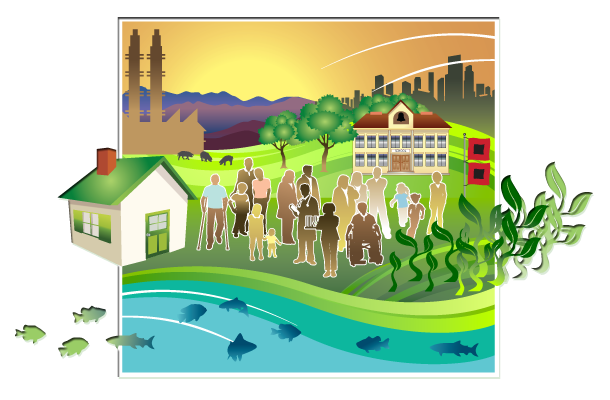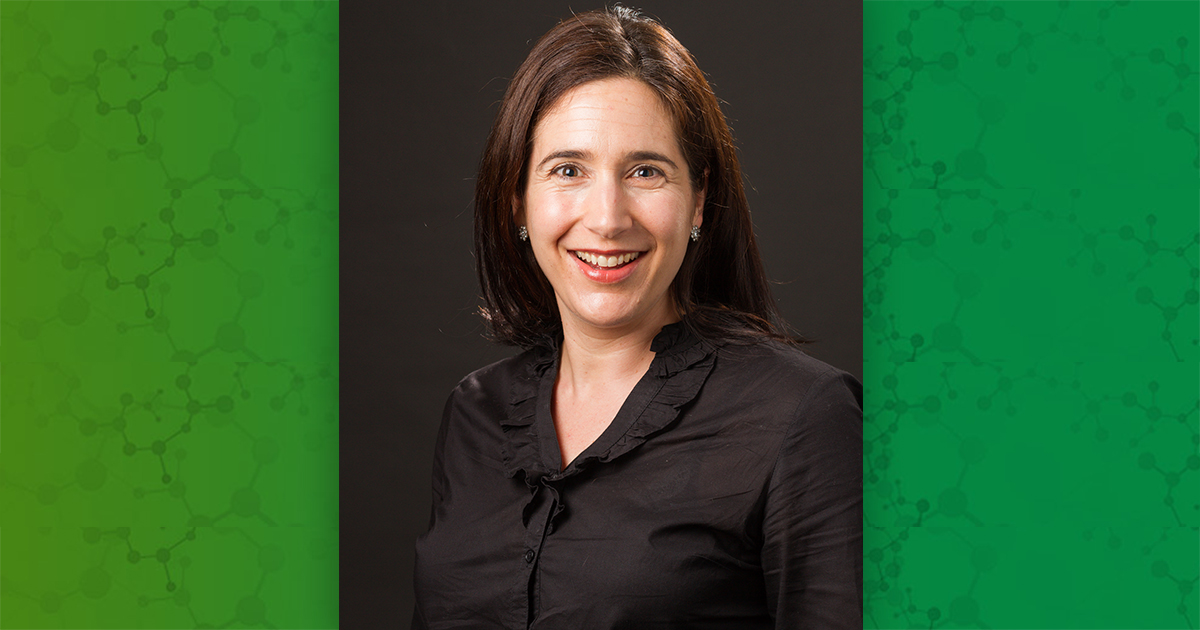From Bottom to Top: A Community-led Approach Provides Understanding of Community Air Pollution Burden
Understanding the distribution of air pollution can help target policies and encourage other actions to reduce exposure. Often, communities experiencing disadvantages and more air pollution lack the air monitoring tools to effectively document pollutant levels.
A community organization in Santa Ana, California, has partnered with researchers at the University of California, Irvine to characterize disparities in local air pollution monitoring. Their disparities in access to air quality sensors and a community-engaged project to overcome gaps in air monitoring data are described in papers published in early 2022.
Residents Monitor Their Neighborhood
Residents of the Madison Park neighborhood in southeast Santa Ana, an immigrant, Hispanic/Latino, and low-income area, became concerned about their exposure to air pollution when they learned of a new metal plating facility moving into the area. This facility sparked residents to take action regarding their environmental exposures and health.
Neighbors began comparing their experiences with fumes, odors, and noise from local industries, as well as health problems like asthma. Although eager to address their health concerns, they were limited in understanding their exposure because of few air sensors in the area.
A local community organization, Getting Residents Engaged in Empowering Neighborhoods – Madison Park Neighborhood Association (GREEN-MPNA), convened a committee of adults and high school youth to investigate local environmental health risks. They named the group "Comunidad Unida, Aire Limpio" (Community United for Clean Air, or CUAL). With a grant from the California Air Resources Board, GREEN-MPNA undertook a three-year community science pilot project in which residents partnered with environmental health and social science researchers from the University of California, Irvine.
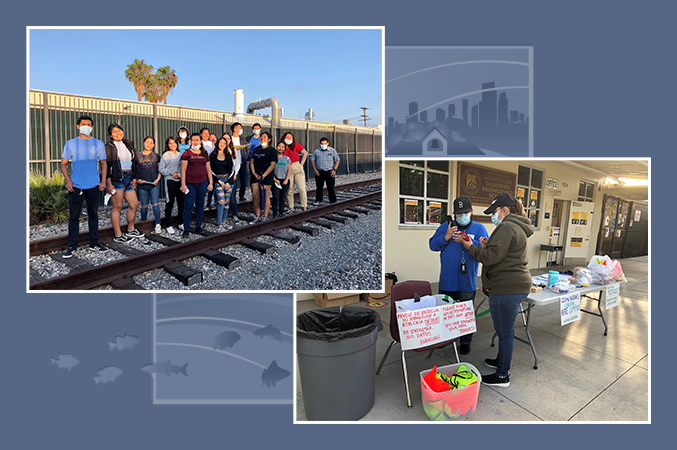
(Left) High school student volunteers gather at an air sampling event. (Right) Community partners stage a sampling event with instruction materials and supplies. (Photos courtesy of GREEN-MPNA)
GREEN-MPNA and their academic partners developed community workshops on environmental justice advocacy, community-based research, and air pollution health risks. Through these workshops and additional focus groups, the partnership identified three major research goals:
- Identify areas with high air pollution and its associated sources.
- Compare air pollution in the community to that of less disadvantaged communities near Madison Park.
- Understand the health effects of air pollution exposure in their neighborhood.
After forming the research questions, CUAL engaged with the researchers to develop and carry out the research plan.
First, researchers trained community volunteers on how to take samples with wearable air monitoring devices provided by the community air grant. Sampling took place three times per day (morning, midday, and evening) on one day per month for four months. CUAL members and other community volunteers walked or biked along assigned routes in the community to capture samples from areas of interest. Community members and researchers also developed a sampling plan to compare pollution from GREEN-MPNA’s areas of concern with pollution in neighboring areas in and around Santa Ana. To sample these other areas, they assigned locations to volunteers at varying distances from the focus area in Madison Park.
Performing community-based research using low-cost air monitors supported GREEN-MPNA’s main objectives of understanding the cumulative effect of breathing air from industrial sources and other polluting sources around the Madison Park neighborhood and of assessing how to improve the situation.
“Perhaps what is different about our approach is that it is from the bottom to the top. The real-world knowledge of the CUAL high school and adult residents paired with the university scientists’ knowledge will transform policy and systems,” stated Jose Rea, Executive Director of GREEN-MPNA.
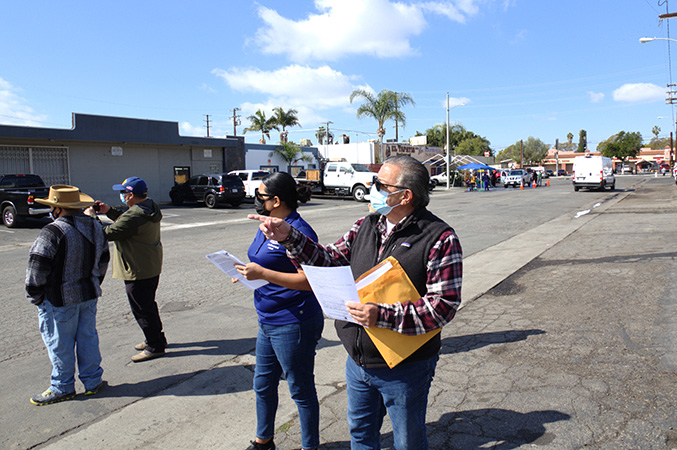
Community partners take part in an air sampling event. (Photo courtesy of GREEN-MPNA)
The Community’s Air Monitoring Results
Sampling indicated that average air pollution levels for each sampling area were below federal regulatory standards, but researchers noted that some individual measurements were much higher than regulatory standards. The data showed that the industrial area and locations near freeways had the highest pollution levels. Wealthier neighboring communities had similar average pollutant levels but had fewer measurements above the regulatory benchmark than did the Madison Park neighborhood.
“We believe the frequency of measurements that exceeded the benchmark shows this community may have a higher pollutant burden than those nearby,” stated Shahir Masri, Sc.D., first author of this community academic study.
Going forward, researchers and community members hope to get access to air quality monitoring equipment to better understand air pollution patterns in the Madison Park area. Monitoring over time with additional sensors would show whether pollutants were violating standards. The community continues to advocate for policies to mitigate existing pollution sources and prevent new pollution sources while expanding access to air monitoring sensors in environmental justice areas. The researchers and GREEN-MPNA also plan to continue to work together to better understand the health effects of air pollution exposure in the community.
Disparities in Access to Air Pollution Sensors
As this community-academic study progressed, researchers wondered whether the total number of air monitoring sensors per neighborhood would follow boundaries of race and income throughout California as they did in Santa Ana. They examined placement patterns of a widely used, low-cost sensor that is often distributed through state-sponsored air monitoring programs. The sensors upload air quality and location data to an online platform. Researchers used CalEnviroScreen — a state-maintained mapping tool that tracks pollution and socioeconomic data — to compare sensor distribution with socioeconomic factors.
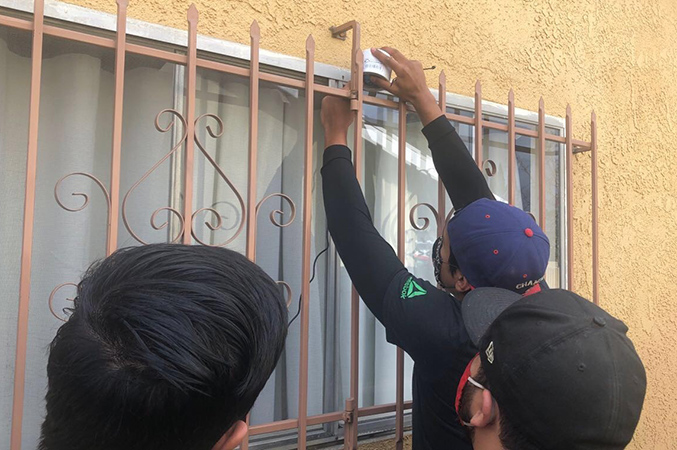
The same type of low-cost sensor as examined in the statewide study (PurpleAir) is placed outside a Santa Ana home by a GREEN-MPNA community partner as part of another project following the neighborhood study referenced in this article. (Photo courtesy of GREEN-MPNA)
Researchers found that disparities in air pollution data existed throughout the state. Wealthier areas across California had more sensors than low-income areas, and there was a clear relationship between sensor distribution and race. Except for Asian Americans, residents of color were more likely to live in areas with fewer air sensors compared to areas with mostly white residents. Strikingly, regions with higher air pollution measurements had fewer sensors than regions with less air pollution.
“Unfortunately, this is a common environmental justice pattern, where the areas that are most affected by environmental issues have the least number of resources to address them,” reflected Jun Wu, Ph.D., principal investigator of the project. “Wealthier residents are better equipped to buy their own sensors, but state funding has not addressed the gap for poorer areas that have more air pollution. We have been pleased to work with organizations who are meeting this challenge head-on through community-led air monitoring.”
Community Research Partnership Empowers Residents to Further Investigate Neighborhood Air Pollution
An NIEHS-funded group of researchers published a paper in June describing a Seattle-based project that used heavy metals in moss to guide environmental justice investigation. The group’s earlier work on moss and air pollution was featured in the December 2020 PEPH newsletter.
For the group’s more recent work, the researchers engaged community members to map heavy metals using moss. The mapping was performed across an industrial neighborhood known for its poor air quality and health disparities. The area has only one monitor for heavy metals, so the researchers wanted to use the results from the moss study to inform where and how to invest resources to further study heavy metal pollution. Residents were engaged in sampling moss from trees in the area, and the team used the samples to map 21 chemicals, including six toxic priority metals, such as arsenic, chromium, cadmium, and lead. They found that the moss in the area had relatively high concentrations of priority metals. This result led community residents to ask two regulatory agencies, the U.S. Environmental Protection Agency and the Puget Sound Clean Air Agency, for a study to evaluate human exposure to heavy metals. The study, which is ongoing in 2022, will measure metals in airborne soil and dust, as the moss results suggest these substances may be important carriers of priority metals. Community partners will choose the locations to which air monitors are deployed based on local knowledge and the results of the moss study. Results from this second study will help determine whether the metals are hazardous to human health and will inform the community partners’ further investigations.
Environmental Health Perspectives Journal Updates Curated Collection on Per- and Polyfluoroalkyl Substances
The journal Environmental Health Perspectives published its curated 2022 Per- and Polyfluoroalkyl Substances (PFAS) collection in June. The collection focuses on newly identified PFAS, exposure pathways, pregnancy and child health outcomes, adult disease, and prenatal and early exposures, and it reflects research published since the journal’s 2019 PFAS collection. The papers in the collection also describe areas of future research. The articles cover a variety of health-related topics in the context of PFAS, such as cardiovascular risk, youth growth trajectories and glucose homeostasis, bone mineral density, attention-deficit/hyperactivity disorder, and autism spectrum disorder.
PFAS have been gaining attention in the environmental health community because of their potential for contributing to negative health outcomes across the life span. Furthermore, PFAS exposure is pervasive, and although much of what is known about the health effects of PFAS is derived from overtly exposed populations, recent research has underscored the importance of studying multiple exposure levels, a focus that is reflected in this current collection.
NIEHS Environmental Health Language Collaborative’s Use Cases Webinar Now Available
The NIEHS-sponsored Environmental Health Language Collaborative, which aims to develop and implement a harmonized language for describing environmental health science research and ultimately to advance integrative environmental health research, held a webinar on environmental health use cases in April. The webinar recording is now available. Throughout the fall of 2021, working groups refined the use cases, which collectively cover data discovery, data harmonization, place-based exposures, and biomarkers and biological outcomes. During the webinar, representatives from each working group presented updates and answered question about their use cases. For example, the first use case, on data discovery, addresses the problem of finding and integrating relevant information to address environmental health science questions. Because information is currently stored in various formats that lack standardization, there is difficulty in making the most of environmental health sciences data. To address these issues, the working group aims to create tools and strategies to facilitate interoperability of existing databases. They are working on creating a standardized minimum information reporting template, and in the longer term, they hope to develop standards to support the creation and sharing of structured data.
NIEHS-funded Researchers Release Data Science Training for Beginners
NIEHS-funded researchers at UNC Chapel Hill, together with other team members, have developed a training toolkit intended to help researchers leverage data science and computational methods to better identify relationships between environmental exposures and human disease outcomes. The inTelligence And Machine lEarning (TAME) Toolkit is organized into training modules that collectively cover a variety of topics such as data organization; finding and visualizing data trends; findable, accessible, interoperable, and reusable data management practices; dose-response modeling; mixtures analyses; and database integration. Each module provides applications-driven examples relevant to environmental health questions and was designed to appeal to beginner learners, including students and professionals in academia, government, and industry who are interested in expanding their skillset. The developers published a paper in June describing how they created the tool.
NIH Launches Transdisciplinary Climate Change and Health Initiative
The NIH Climate Change and Health Initiative is a cross-cutting NIH effort created to address health threats from climate change and build resilience in individuals and communities. Seven institutes and centers within NIH will work together, bringing a variety of technologies and research approaches to advance the understanding of climate change and health. The initiative’s strategic framework was published in February and explains the importance of involving impacted communities and focusing on solutions, rather than solely studying the health effects of climate change. The framework focuses on four core elements—health effects research, health equity, training and capacity building, and intervention science—which will shape research into the initiative’s nine fields of inquiry, such as adaptation research, behavioral research, data integration, implementation science, predictive modeling, and exposure and risk assessment. The initiative will first leverage existing grant programs but has also identified future research needs which will be addressed later. Richard Woychik, Ph.D., director of NIEHS, wrote a blog on how the initiative will expand research and build resiliency.
White House Council on Environmental Quality Seeks Feedback on Environmental Justice Scorecard
The White House's Council on Environmental Quality recently released a request for information to gather public feedback regarding its Environmental Justice Scorecard. The scorecard was mandated by Executive Order 14008 and will examine the federal government’s progress on environmental justice efforts. The scorecard reflects the administration’s commitment to deliver tangible benefits to communities and to ensure the needs of communities are part of decision making. It organizes federal efforts into three reporting categories:
The public is invited to submit comments on the framework, the project’s vision, and ways to enhance engagement in developing and sharing the scorecard. Comments may be submitted through October 3.

PEPH Grantee Highlight
Yoshira ‘Yoshi’ Ornelas Van Horne, Ph.D.
Yoshira Ornelas Van Horne, Ph.D., believes that to fully characterize people’s environmental exposures, their stories and lived experiences need to be understood, so she takes a community-centered approach to her exposure research. Her research interests were shaped by her NIEHS-funded graduate work on understanding exposure risk for Diné (Navajo) communities after the 2015 Gold King Mine spill which polluted the San Juan River. An initial risk assessment was based on the needs of outdoor recreationalists but did not consider how Diné people interacted with the river. Ornelas Van Horne and her Diné partners conducted focus groups – which were previously described in the January 2022 PEPH newsletter – and surveys to learn how the Diné relied on the river. The team then shared research results through culturally appropriate materials. From this work, she realized how important it is for researchers to partner with communities to answer the communities’ questions. As a post-doctoral fellow at the University of Southern California, Ornelas Van Horne worked on an NIEHS-funded study that addressed community concerns about pesticide exposure and children’s respiratory health. She is now an assistant professor at Columbia University.
Funding Opportunities
PHS 2022-2 Omnibus Solicitation of the NIH, CDC and FDA for Small Business Innovation Research Grant Applications (Parent SBIR [R43/R44] Clinical Trial Not Allowed)
Enables U.S.-owned and operated small businesses to conduct research and development that has a strong potential for commercialization. This award and the associated PHS 2022-2 Omnibus Solicitation of the NIH and CDC for Small Business Innovation Research Grant Applications (Parent SBIR [R43/R44] Clinical Trial Required) provide funds for small businesses to stimulate technological innovation in the private sector and strengthen the role of small business in meeting federal research and development needs. The related Small Business Technology Transfer announcements (PHS 2022-2 Omnibus Solicitation of the NIH for Small Business Technology Transfer Grant Applications (Parent STTR [R41/R42] Clinical Trial Not Allowed) and PHS 2022-2 Omnibus Solicitation of the NIH for Small Business Technology Transfer Grant Applications (Parent STTR [R41/R42 Clinical Trial Required)) aim to foster technology transfer through cooperative research and development between small businesses and research institutions.
Deadlines: September 5, 2022; January 5, 2023; April 5, 2023
Accelerating the Pace of Child Health Research Using Existing Data From the Adolescent Brain Cognitive Development (ABCD) Study (R01-clinical Trial Not Allowed)
Supports activities proposing to conduct analyses of existing ABCD Study data to accelerate the pace of research on child health and development, including: cross-sectional and/or longitudinal analyses; development of new or advanced statistical methods; and/or integration of ABCD data with other existing datasets that share common data elements. NIEHS is interested in applications that will use ABCD data resources to examine the contribution of environmental exposures on brain and development and to identify sensitive time windows of development that may confer individual susceptibility and also to identify protective factors that may mitigate environmental-induced changes. An R21 funding opportunity is also open.
Deadlines: June 5, 2022; October 5, 2022; February 5, 2023
Notice of Special Interest (NOSI): Climate Change and Health
Encourages applications that address the impact of climate change on health and well-being over the life course, including the health implications of climate change in the United States and globally. NIEHS is leading the NIH-wide Climate Change and Health Initiative, of which this NOSI is a part. NIEHS is interested in research that addresses the impact of climate change on environmental health and innovative approaches to the development of prevention and intervention strategies to reduce the impacts of climate change on environmental health, particularly in communities most susceptible to these impacts. Researchers who wish to submit applications regarding this NOSI must select from a list of funding opportunity announcements sponsored by various NIH institutes and centers. Researchers interested in applying for climate change-related Small Business Innovation Research funding can see Notice of Special Interest (NOSI): Innovative Technologies for Research on Climate Change and Human Health (R43/R44 Small Business Innovation Research (R43/R44 Clinical Trial Optional). Researchers interested in applying for climate change-related Small Business Technology Transfer funding can see Notice of Special Interest (NOSI): Innovative Technologies for Research on Climate Change and Human Health Small Business Technology Transfer (R41/R42 Clinical Trial Optional).
Deadlines: August 8, 2022; October 5, 2022; November 3, 2022
Research to Action: Assessing and Addressing Community Exposures to Environmental Contaminants (R01 Clinical Trial Optional)
Encourages multidisciplinary projects to investigate the potential health risks of environmental exposures of concern to a community and to implement an environmental public health action plan based on research findings. Projects supported under this program are expected to employ community-engaged research methods to not only conduct research but also to seamlessly translate research findings into public health action. Check out the Research to Action Currently Funded Grantees webpage for a sense of the types of projects supported through this FOA.
Deadline: January 21, 2020
Research Enhancement Award Program (REAP) for Health Professional Schools and Graduate Schools (R15 Clinical Trial Not Allowed)
The REAP program will enable qualified scientists to receive support for small-scale research projects. It is anticipated that investigators supported under the REAP program will benefit from the opportunity to conduct independent research; that the grantee institution will benefit from a research environment strengthened through REAP grants; and that students at recipient institutions will benefit from exposure to and participation in scientific research in the biomedical sciences so that they consider careers in biomedical research. The REAP funding opportunity emphasizes the engagement and inclusion of health professional, undergraduates, and/or graduate students in research. Since diversity strengthens the research environment, REAP grantees are encouraged to recruit and include students from diverse backgrounds, including those from groups underrepresented in the biomedical research workforce. NIEHS will accept applications describing research projects that will have a defined impact on the environmental health sciences and must have a research focus on exposure-health related responses from environmental agents within the mission interest of the NIEHS.
Deadlines: June 25, 2022; October 25, 2022
Notice of Special Interest (NOSI): Administrative Supplements for Research on Sex And/Or Gender Influences (Admin Supp Clinical Trial Optional)
Supports research highlighting the impact of sex and/or gender influences in human health and illness. The proposed research must address at least one objective from the five strategic goals of the 2019-2023 Trans-NIH Strategic Plan for Women's Health Research. A broad range of research topics studied at the basic, pre-clinical, translational, and clinical levels that address the role of sex and/or gender in health and disease are encouraged. Studies that explore sex or gender influences or the intersection of sex and gender are also encouraged.
Deadlines: January 26, 2022; January 26, 2023




